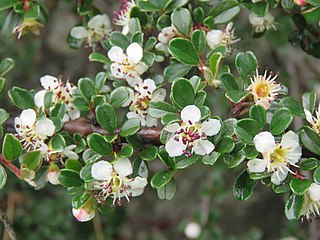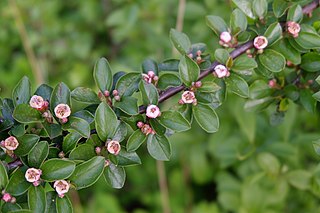
Royal Botanic Gardens, Kew is a non-departmental public body in the United Kingdom sponsored by the Department for Environment, Food and Rural Affairs. An internationally important botanical research and education institution, it employs 1,100 staff. Its board of trustees is chaired by Dame Amelia Fawcett.

Selenicereus, sometimes known as moonlight cactus, is a genus of epiphytic, lithophytic, and terrestrial cacti, found in Mexico, Central America, the Caribbean and northern South America. The term night-blooming cereus is also sometimes used, but this is also used for many night-blooming cacti, including Epiphyllum and Peniocereus. In 2017, the genus Hylocereus was brought into synonymy with Selenicereus. A number of species of Selenicereus produce fruit that is eaten. The fruit, known as pitaya or pitahaya in Spanish or as dragon fruit, may be collected from the wild or the plants may be cultivated.

Actinolema is a genus of plants in the family Apiaceae. They are found in Southwest Asia and the Caucasus.
Puya eryngioides is a species of plant in the family Bromeliaceae. It is endemic to Ecuador. Its natural habitat is subtropical or tropical high-altitude grassland. It is threatened by habitat loss.
Laser is a genus of flowering plant in the family Apiaceae, native from Europe to northern Iran. The genus was first described in 1799.

Seidlitzia stocksii is a shrub species of the family Amaranthaceae.
The Plant List was a list of botanical names of species of plants created by the Royal Botanic Gardens, Kew and the Missouri Botanical Garden and launched in 2010. It was intended to be a comprehensive record of all known names of plant species over time, and was produced in response to Target 1 of the 2002-2010 Global Strategy for Plant Conservation, to produce "An online flora of all known plants.” It has not been updated since 2013, and has been superseded by World Flora Online.
The World Checklist of Selected Plant Families is an "international collaborative programme that provides the latest peer reviewed and published opinions on the accepted scientific names and synonyms of selected plant families." Maintained by the Royal Botanic Gardens, Kew, it is available online, allowing searches for the names of families, genera and species, as well as the ability to create checklists.
Ian Charleson Hedge was a Scottish botanist at the Royal Botanic Gardens in Edinburgh. Hedge made important contributions to the flora of Iran and Iraq, and was a recognised authority on the flora of south-west Asia. He named more than 300 new plant species.
Plants of the World Online (POWO) is an online database published by the Royal Botanic Gardens, Kew. It was launched in March 2017 with the ultimate aim being "to enable users to access information on all the world's known seed-bearing plants by 2020". The initial focus was on tropical African Floras, particularly Flora Zambesiaca, Flora of West Tropical Africa and Flora of Tropical East Africa.

World Flora Online is an Internet-based compendium of the world's plant species.
Ianhedgea is a monotypic genus of flowering plants belonging to the family Brassicaceae. It only contains one species, Ianhedgea minutiflora(Hook.f. & Thomson) Al-Shehbaz & O'Kane
Kozlovia is a genus of flowering plants belonging to the family Apiaceae.
Stewartiella is a monotypic genus of flowering plants belonging to the family Apiaceae. According to Kew; it only contains one known species, Stewartiella crucifolia(Gilli) Hedge & Lamond

Syringa × chinensis, the Chinese lilac or Rouen lilac, is a hybrid species of flowering plant in the family Oleaceae. It was supposedly first noticed growing in Rouen, France in 1777. In spite of its specific and common names, it most probably originated in western Asia. It is the result of a cross between Syringa vulgaris and Syringa persica. A shrub or shrubby tree reaching 12 ft (4 m), it is hardy in USDA zones 3 to 7, and is recommended for borders, loose hedges, and foundations.

Cotoneaster microphyllus, the small-leaved cotoneaster or rockspray cotoneaster, is a species of flowering plant in the family Rosaceae. It is native to the Indian Subcontinent, Tibet, Sichuan, and Yunnan in China, and Myanmar, and it has been introduced to various locales in Europe, Australia, and the United States. A rabbit-tolerant shrub reaching 1 m (3 ft) tall but spreading to 2.5 m (8 ft), and hardy in USDA zones 5 through 7, it is recommended for rockeries and hedges. Care should be taken not to plant it where it can become invasive.

Cotoneaster divaricatus, the spreading cotoneaster, is a species of flowering plant in the family Rosaceae. It is native to China, and has been introduced to Ontario in Canada, the Midwest United States, northern and central Europe, Kenya, and the South Island of New Zealand. A shrub reaching 1.8 m (6 ft) tall but spreading to 2.4 m (8 ft), and hardy in USDA zones 4 through 7, it is considered a valuable landscaping plant by the Missouri Botanical Garden. The Centre for Agriculture and Bioscience International lists it in its Invasive Species Compendium.

Osmanthus suavis, the sweet olive or sweet osmanthus, is a species of flowering plant in the family Oleaceae, native to the slopes of the Eastern Himalayas. An evergreen shrub typically 6–12 ft (2–4 m) tall, and hardy in USDA zones 8 and 9, it is prized for its floral fragrance and is recommended for hedges. Its leaves are dark green and lanceolate to oblong in shape. It grows in dense forests and thickets on slopes.

Indigofera amblyantha, the Chinese indigo or pink-flowered indigo, is a species of flowering plant in the family Fabaceae, native to central and southern China. A non‑climbing shrub reaching 6 ft (2 m), it blooms from May to September, and is recommended for hedges, borders, massing, and containers.
Lindera akoensis, the Taiwan spicebush, is a species of flowering plant in the family Lauraceae, endemic to Taiwan, where it is found in thickets. A perennial shrub with fragrant foliage and showy flowers and fruit, it reaches 8 to 10 ft at maturity. It is hardy in USDA zones 8 and 9, and is recommended for hedges, borders, and cottage gardens in partial shade.









